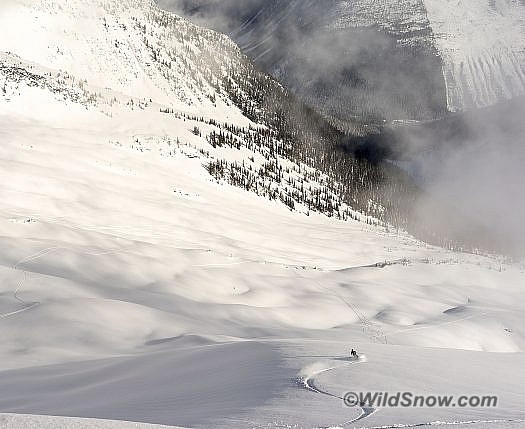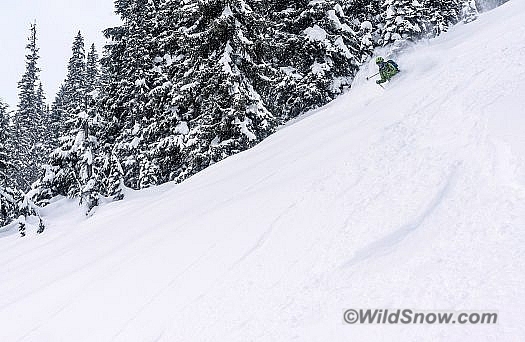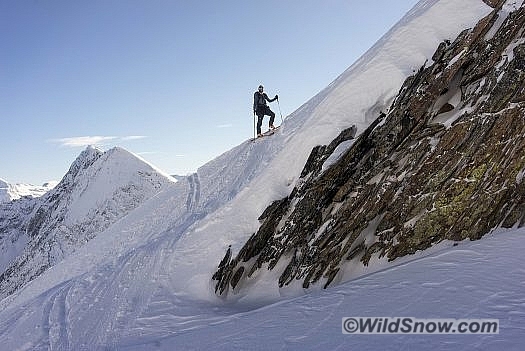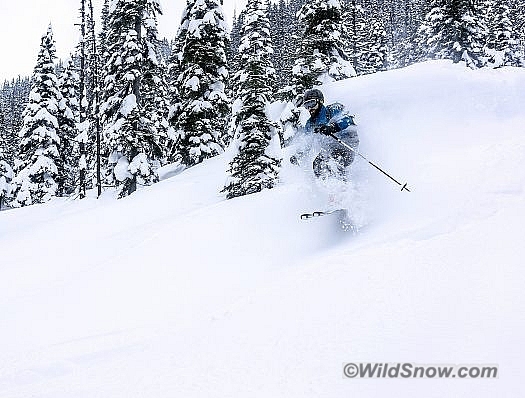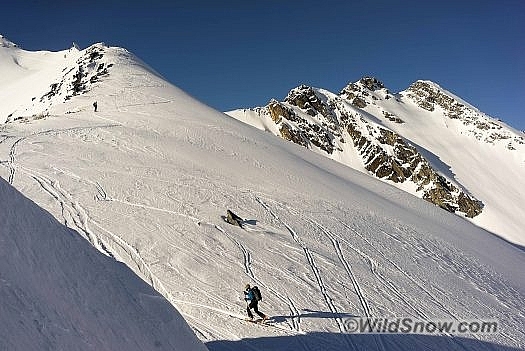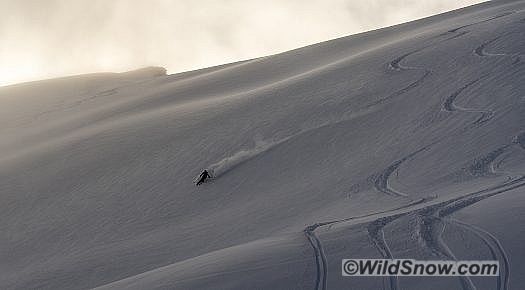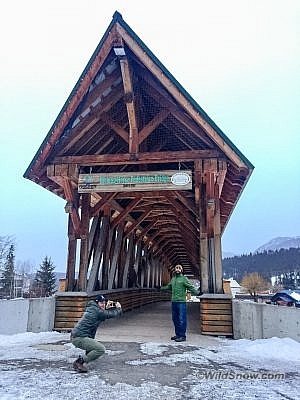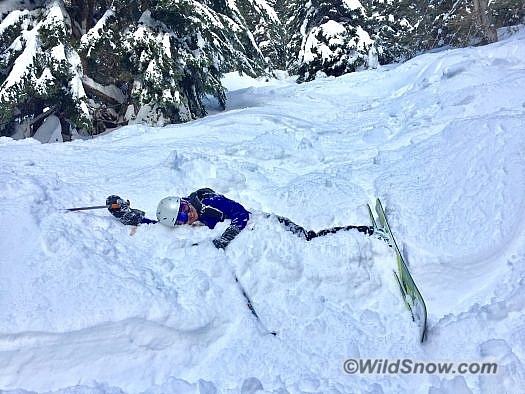Funny how the weather changes according to how tired you are. About 25,000 vertical feet into the trip, the weather looked bad, but honestly, we were just tired. Some places live up the hype: Rogers Pass, British Columbia is one of them.
Maple syrup, winter, and exchange rates that favor the American dollar are a few of my favorite things. For those that agree, Canada is not to be missed. I have made a habit of venturing behind the maple curtain over the past decade for ski trips, but until this month, I had yet to to travel to Rogers Pass, a highlight of the ski touring world.
More than a hundred years before we rented a minivan to join the trove of skiers on the pass this January, Major Albert Bowman Rogers led an expedition up the Illecilewaet River from Revelstoke in 1881. He was searching for safe passage to take the still-under-construction Canadian Railroad through the Selkirk Mountains. Three years later, the Canadian-Pacific steamed through Rogers Pass. By the late 30s, backcountry skiing found its way to the pass and after the Trans Canada Highway added incredible accessibility in the mid 1960s, Rogers has become a pilgrimage for many. Five thousand feet of vertical relief, a deep BC snowpack, and a variety of terrain from long steep tree runs, to big glacier tours, to monster couloirs all helps make the pass some of the best easy-to-access backcountry terrain anywhere in the world.
We showed up with a snowstorm and had ten days of phenomenal backcountry skiing. It can be incredibly difficult to figure out new places on the fly. A few things about Rogers Pass made this less of an issue: a useful and informative permit system, a helpful Park visitor center with rangers who ski, a healthy selection of guide books and trip reports, and enough people to cut down on trail breaking (but not so many that it ever felt crowded).
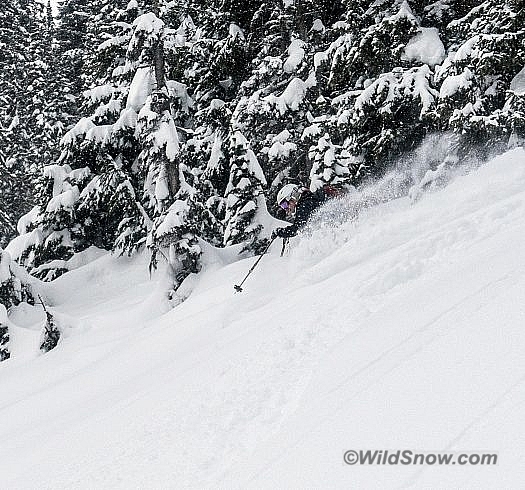
Storm day skiing in in the Illecilewaet Valley – oh so much fun on a run they call the ‘practice slopes,’
Our first day out, all restricted areas were closed, snow was falling, and we were clueless as to where to ski. We headed up the unrestricted Connaught Creek from the trailhead at the Discovery Center (visitor center and ranger station) that all skiers have to visit at least once in order to get a permit (there is not a sign on the highway for the Discovery Center, keep an eye out for it once you are through the avalanche sheds). Balu Pass offers a nice tour to some mellow terrain – although the route passes under impressive slide paths. We wound up the valley to the shoulder of a peak called Ursus Minor. We turned around at treeline and skied a smooth open glade back down for our first taste of ‘Capow’ (Canadian powder). After a good long run, but before the valley floor we put skins on. The Parks Canada ranger that we got our permit from had pointed out this spot on the map.
“Everyone skis down here,” he said, pointing to a drainage in a picture of the valley. He continued, “But it’s really bad. Some people ski the Christmas Trees — that’s dumb too.”
The Parks Canada folks are careful not to tell you where to go, but are welcoming with useful bits of information nonetheless. If you ask a question, they will answer it. He suggested we look at an area called the “Hospital Chutes.” Up Hospital Knob we went, and another thousand feet of awesome stable steep pow led us down one of these chutes through the trees.
The next day a local joined the crew. My friend Cody lives in Calgary and has been skiing Rogers a bunch this year, so we followed his lead to an area called McGill. The skin track up to McGill Shoulder was about 3000 feet up to treeline. We couldn’t see the run Cody promised was there until we were right on top of it. A couple tracks had beat us to the ‘gun-barrels’ but plenty of open terrain in the area was still untouched.
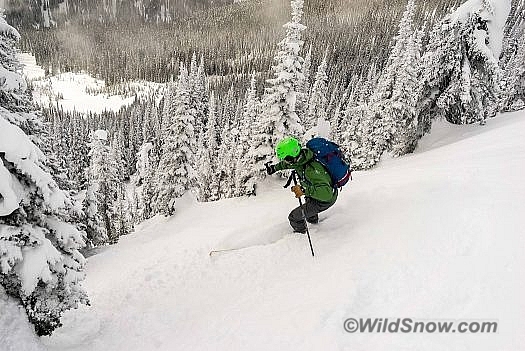
Cody assured us the trees opened up. It’s always nice to follow a local — indeed awesome tree skiing abounds at McGill Shoulder.
“Breakfast meats.” Someone in the group said, while I mentioned, “Little smokies!” with some excitement at the same time.
I guess they call those sausages something else in Canada, because the woman laughed and said, “So a morning smoke is the secret to breaking trail, eh?”
We tried to correct her — maybe the groups enthusiasm misrepresented us?
One of the best parts of this terrain was that there was something for everyone in a group with diverse comfort zones and abilities: open trees, tight trees, more mellow skiing, and big pillows to jump of off.
Skiing back down to the skin track, we zipped through a pillow playground. We hoped, and popped, and jumped while yipping through the trees. Clambering on top of one particularly monolithic pillow just to jump off, summed up this fairyland forest as the perfect terrain park for my inner child. Once my poor rendition of 180s and spread eagles started coming out, Margi was certain a knee injury was imminent. Luckily the inner child won out this time.
The next morning, we finally had some sunshine. Cody, John, and I headed up ‘Bruins Ridge,’ after hearing the Parks Canada guy talk about it as one of his favorite spots in the park. We had a bit less stability and were approaching our route with more caution. At the top of the ridge we got a good look at a skier triggered avalanche from the day before (no one was hurt). It was on the same aspect and elevation as the entrance to our planned descent – we changed plans. This led to the best runs of the week. The wide ramp arcing into a huge alpine bowl we chose skied perfectly. The views that day where as impressive as it gets too – and that’s coming from someone with the Alaska Chugach out my backdoor.
Resources: Several binders at the Discovery Center have pictures and route information for the area that offer insight into possible tours – we used these nearly every day. Two popular guidebooks also present write-ups on Rogers’ terrain. Our AirBnB host in Golden lent both to use for the trip. Rogers Pass: Uptracks, Bootpacks, and Bushwacks by Douglas Sproul is an impressive collection of big lines across the area. The Sproul book was mostly aspirational for us. It’s a bit short on information for storm day skiing, moderate terrain, hot-laps, and shorter tours, but excels at inspiring write-ups for stable conditions and sunny weather, as well as a solid orientation to the different areas in the pass. Despite not using Sproul book much for planning outings during a week and a half of mostly storm skiing, at the end of the trip I picked up a copy to keep on bookshelf for the sake of procrastination. Summits & Icefields: Alpine Ski Tours in the Columbia Mountains by Chic Scott and Mark Klassen also has the basics covered, as well as a few more introductory options, but Rogers Pass is one section in this book that covers a much broader region. Both books are wonderful, but follow your nose, ask the rangers, look in the Discovery Center binders, and ask around to find more info on specific tours.
The rest of the trip allowed us time to explore, and get some epic tree skiing, which I have been really missing since moving to AK (tree line is too low here).
We stayed in Golden, BC about an hour east of the pass. Golden is an old west-meets-hipster town that I appreciated. The Indian food at ‘Indian Kitchen’ was the perfect apres ski. Catching their monthly all-you-can-eat buffet night was a deal not to be missed. The brewery in town is also a tasty place to end up at the end of the day. While skate skiing isn’t exactly a low energy activity – the Nordic center in Golden made for a perfect shorter ‘rest day’ outing (especially when coupled with paying exploding kittens back at our place).
Just outside Golden, the Kicking Horse Mountain Resort bills itself as the ‘champagne powder capital of Canada.’ Our last day of the trip we toured past the bottom of Kicking Horse into Dogtooth Range, finding our way to ‘the molars.’ Although this was a bit busier than the pass, the tour was beautiful and it was worth checking out.
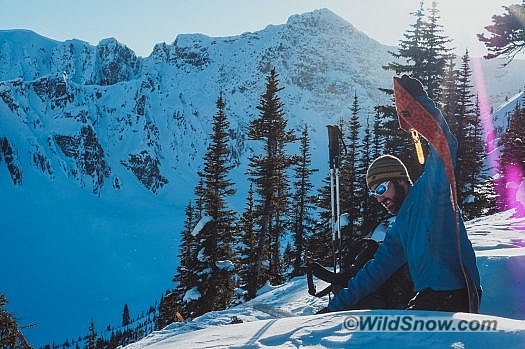
Cutting our teeth on the ‘Molars.’ The Dogtooths were a beautiful bit of new scenery at the end of the trip. Photo by Taylor Bracher
South Central AK had a phenomenal New Years snow pack, but a brewing January thaw has meant rain the last couple of weeks. Luckily British Columbia took me in for a week and half of refuge. I can not recommend Rogers Pass enough. Sure we saw other people, and sure we had to drive a good way from town each day, and sure there is a bit of a hassle going through the permit system. But the friendly locals, gorgeous mountains, and epic access makes it a place I will definitely go back too.
Dr. Alex Lee lives in Anchorage, Alaska. Alex is a professor at Alaska Pacific University, teaching philosophy and environmental studies. He also works as a sometimes guide, naturalist, writer, and photographer.

